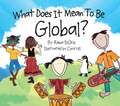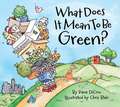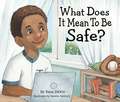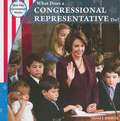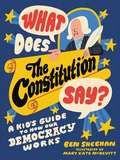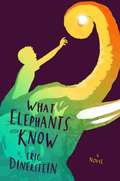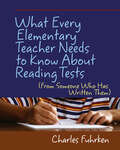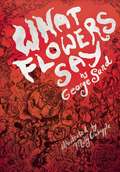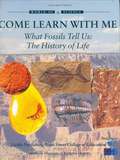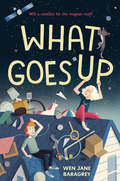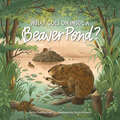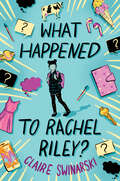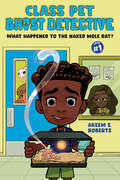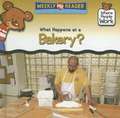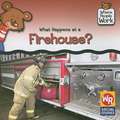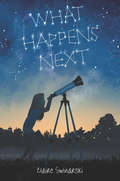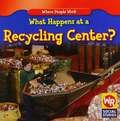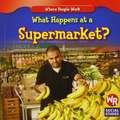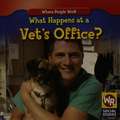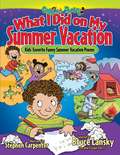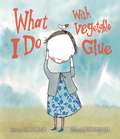- Table View
- List View
What Does It Mean To Be Global?
by Rana DiorioCan you say "hello" in nine languages? You can! Join children from around the world as they play, sing, and travel, trying all types of food and experiencing other traditions. Living respectfully and peacefully with one another, they celebrate diversity, see how their actions affect another person's experience, and come to understand that being global means being a citizen of the world.
What Does It Mean To Be Green?
by Chris Blair Rana DiOrioDrawing on two sides of your paper instead of just one. Walking to the park instead of getting a ride. Turning off the water while you brush your teeth. A young boy and girl explore all the different ways they can be Green over the course of a day. They discover lots of amazing facts (like our food travels an average of 1,500 miles to be on our plate!) and realize there's so much they-and we-can do to save our world!
What Does It Mean To Be Safe?
by Sandra Salsbury Rana DiOrioAs a young boy and his friends go on an outing to the local river and then return home, they look out for one another, resist peer pressure, and listen to their inner voices to know the right thing to do. Along the way, the boy discovers that each of us is the single best person to protect our precious self, and that there are so many things we can all do to be safe!
What Does a Congressional Representative Do?, First Edition (How Our Government Works)
by David J. JakubiakDiscusses the duties of congressional representatives, how they get into office, how states are represented, the leadership of the House of Representatives, working with the Senate, committees, and where the House meets.
What Does the Constitution Say?: A Kid's Guide to How Our Democracy Works
by Ben SheehanIf you've never read the Constitution, let this guidebook help you! Featuring fun facts, cool illustrations, and even hilarious jokes, What Does the Constitution Say? will help you understand how our American government really works. Written more than 230 years ago, the Constitution can be hard to understand (even for adults). But it also gives you what you need to make our country the best it can be for everyone. What Does the Constitution Say? takes you on a tour of the whole Constitution while explaining what its fancy words really mean. From the Preamble to the 7 Articles to the 27 Amendments (so far), this fun-to-read guide is packed with bite-sized info, historic quotes, and graphics on important topics such as:Why the Constitution is a "living document"How the first attempt at a constitution (the Articles of Confederation) failedWhat powers the president does (and doesn't) haveKey figures like James Madison, Alexander Hamilton, and George WashingtonA bonus section on the Declaration of IndependenceAnd much more!
What Eats What in a Forest Food Chain (Food Chains Ser.)
by Lisa J. AmstutzA temperate deciduous forest teems with life. From a tall oak tree to a turkey vulture, the living things in this books are linked together in a food chain. Each one of them needs the others in order to live. Find out what eats what in a forest!
What Elephants Know (What Elephants Know Ser.)
by Eric DinersteinAbandoned in the jungle of the Nepalese Borderlands, two-year-old Nandu is found living under the protective watch of a pack of wild dogs. From his mysterious beginnings, fate delivers him to the King's elephant stable, where he is raised by unlikely parents-the wise head of the stable, Subba-sahib, and Devi Kali, a fierce and affectionate female elephant. When the king's government threatens to close the stable, Nandu, now twelve, searches for a way to save his family and community. A risky plan could be the answer. But to succeed, they'll need a great tusker. The future is in Nandu's hands as he sets out to find a bull elephant and bring him back to the Borderlands. In simple poetic prose, author Eric Dinerstein brings to life Nepal's breathtaking jungle wildlife and rural culture, as seen through the eyes of a young outcast, struggling to find his place in the world.
What Every Elementary Teacher Needs to Know About Reading Tests: (From Someone Who Has Written Them)
by Charles FuhrkenWhen he was a student struggling to concentrate on dreadfully boring passages of standardized reading tests, Charles Fuhrken remembers thinking to himself, 'Who writes this stuff?' He had no idea that one day it would be him. ' Fuhrken has spent years working as a writer for several major testing companies, and he believes that what he's learned about testing could be very usefuleven liberatingfor teachers interested in teaching effective reading strategies as well as preparing students for reading tests. In What Every Elementary Teacher Needs to Know About Reading Tests (From Someone Who Has Written Them), Fuhrken' takes the mystery out of reading tests. He explains how reading tests are created, how standards are interpreted and assessed, and how students can apply their knowledge of reading to standardized tests.' ' What Every Elementary Teacher Needs to Know About Reading Tests sets the record straight about the myths and realities of tests and offers extensive, practical strategies that help students perform well on test day. This ready to use, easy to understand resource provides a wealth of information about reading tests, including high-quality preparation materials; samples of the most frequently assessed reading standards; and more than thirty engaging, core-reading activities. ' Tests require a special kind of savvy, a kind of critical thinking and knowledge-application that is not always a part of classroom reading experiences. That's why teachers need to provide students with sound, specific information about reading tests. Only then can students feel prepared and confident on test day. '
What Explains Similarities And Differences Between Organisms?: Student Activity Guide
by The Smithsonian InstitutionNIMAC-sourced textbook
What Flowers Say
by George Sand Molly Crabapple Holly Erskine HirkoRoses plead to go out to dance; an old oak tree offers advice; paintings of gods and goddesses come alive. In What Flowers Say, renowned writer George Sand dares children to fantasize, to believe in an alternate world. This magical collection, originally penned for her grandchildren, calls into question what is real, a life lesson from someone who refused to accept the gender roles available to women in the nineteenth century. Sand shares her love and immense knowledge of science and mythology, engages issues of class and character, and captures the wonder and determination of a curious child, offering all of us a true sense of infinite possibilities--well beyond the world we live in.George Sand (1804-76) is considered the first professional woman writer of fiction. She wrote many novels, including Indiana and Léila, plays, newspaper articles, and a memoir, Story of My Life. The movie Impromptu is based on her life.Molly Crabapple is a painter, illustrator, and writer based in New York. She has written many books, including Discordia and Week in Hell, and produced work on subjects including the Spanish general strike, her former career as a pinup model, her arrest during Occupy Wall Street, and her visit to Guantanamo Bay. Her illustrated memoir, Drawing Blood, is forthcoming in 2015.
What Fossils Tell Us: The History of Life (Come Learn With Me Series)
by Bridget AndersonThis book examines the ever-unfolding stories these fossils reveal about life on Earth. Dig in and learn how fossils were formed, and find out about some of the important people and places in the field of paleontology (the study of fossils and ancient life).
What Goes Up
by Wen Jane BaragreyWhat goes up . . . comes down on Robyn Tinkerbell Goodfellow's roof! Will a rogue NASA satellite crush her house before Robyn can set things right?Robyn Tinkerbell Goodfellow (yes, that's actually her name) has a target on her roof. Well, not a real one, but everything seems to land there: paper airplanes, lost kites, socks, cats, and once even a skydiver! In the town of Calliope, Robyn and her magnet roof are famous--for being weird. That wasn't such a big deal . . . until now! A rogue NASA satellite is falling out of orbit and is going to hit Earth. NASA says it will probably land in the ocean, but Robyn knows better--that satellite is headed for her roof. To make matters worse, Robyn discovers that she doesn't just have a fairy middle name. When her class reads A Midsummer Night's Dream, she learns that Robin Goodfellow is a fairy! Which means if the satellite flattens her, everyone will laugh at her name in the news stories. Robyn realizes what she needs to do: find her long-lost dad so he can help her change her name and protect her from the satellite! Both surprising and relatable, this middle-grade novel will have readers wishing they could move to the small town of Calliope, laugh with the larger-than-life characters, and race against the clock to save Robyn from NASA's mistake.
What Goes on inside a Beaver Pond?
by Becky Cushing GopDive into the fascinating world of beavers—the swimmers, builders, and engineers of the animal kingdom! What Goes on inside a Beaver Pond? takes kids ages 8 to 10 on a journey through a year in the life of a young beaver (called a "kit"). This is an exciting year as the young beaver leaves her family lodge and moves throughout the Yokun Brook waterways, seeking a new home for herself. Throughout the seasons, vibrant illustrations and descriptions reveal the hidden inner-workings of a beaver lodge, how beavers fell trees with their teeth and create a wetland habitat, how they collect food and ward off predators, and what daily life is like within a beaver colony. Educational side panels enhance the story with details about beaver behavior and anatomy, as well as information about what other animal inhabitants of the pond are up to throughout the year. Author Becky Cushing Gop is an environmental educator and director of Mass Audubon&’s Pleasant Valley Wildlife Sanctuary where the story takes place. Nature illustrator Carrie Shryock&’s lively and charming graphics bring the young beaver&’s story to life for nature-curious kids.
What Happened to Rachel Riley?
by Claire SwinarskiIn this engrossing and inventive contemporary middle grade novel that's Where'd You Go Bernadette? with a #MeToo message, an eighth grader uses social media posts, passed notes, and other clues to find out why a formerly popular girl is now the pariah of her new school. <p><p>Anna Hunt may be the new girl at East Middle School, but she can already tell there’s something off about her eighth-grade class. Rachel Riley, who just last year was one of the most popular girls in school, has become a social outcast. But no one, including Rachel Riley herself, will tell Anna why. <p><p>As a die-hard podcast enthusiast, Anna knows there’s always more to a story than meets the eye. So she decides to put her fact-seeking skills to the test and create her own podcast around the question that won’t stop running through her head: What happened to Rachel Riley? <p><p>With the entire eighth grade working against her, Anna dives headfirst into the evidence. Clue after clue, the mystery widens, painting an even more complex story than Anna could have anticipated. But there’s one thing she’s certain of: If you’re going to ask a complicated question, you better be prepared for the fallout that may come with the answer.
What Happened to the Naked Mole Rat?: A Graphic Novel (Class Pet Ghost Detective)
by Akeem S. RobertsThe first book in a funny supernatural graphic novel series for early readers about an eight-year-old boy who solves mysteries with the ghost of his former class pet.Mr. Pebbles is dead, and everyone thinks it&’s Carter&’s fault!When Carter&’s third-grade class accuses him of killing the class pet, a naked mole rat named Mr. Pebbles who shivers a lot and smells a little funny, can Carter clear his name . . . with the help of Mr. Pebbles's ghost?
What Happens At A Bakery? (Where People Work)
by Kathleen Pohl Susan NationsDescribes what Mr. Lopez the baker does when he makes a birthday cake for a customer.
What Happens At A Firehouse? (Where People Work)
by Kathleen PohlWeekly Reader's first-grade pal, Buddy Bear, guides a behind-the-scenes tour at each of six important businesses that are found in almost every community. Designed to support the first-grade social studies curriculum, this series uses vivid, full-color photography and first-hand, expert information to show young readers the kinds of work people do at these familiar and fascinating places.
What Happens Next
by Claire SwinarskiIn this heartfelt and accessible middle grade novel perfect for fans of The Thing About Jellyfish, a young girl throws herself into solving a local mystery to keep from missing her older sister, who has been sent to an eating disorder treatment facility. <P><P>Astronomy-obsessed Abby McCourt should be thrilled about the solar eclipse her small town of Moose Junction is about to witness, but she’s not. After her older sister Blair was sent away for an eating disorder, Abby has been in a funk. <P><P>Desperate to dull the pain her sister’s absence has left, she teams up with a visiting astronomer to help track down his long-lost telescope. Though this is supposed to take Abby’s mind off the distance between her and Blair, what she finds may bring her closer to her sister than she ever thought possible.
What Happens at a Recycling Center (Where People Work Series)
by Kathleen PohlThis book demonstrates how a recycling center operates.
What Happens at a Supermarket? (Where people work)
by Amy HutchingsWhat Happens at a Supermarket? takes readers inside a supermarket to meet the workers who help people get their groceries.
What Happens at a Vet's Office (Where People Work Series)
by Amy HutchingsThis book describes in detail a visit to the vet’s clinic.
What Happens to Our Trash? (Let's-Read-and-Find-Out Science 2)
by D. J. WardRead and find out about how we can reduce, reuse, and recycle in this colorfully illustrated nonfiction picture book."Perfect for classes just beginning to study environmental concerns," wrote School Library Journal. "Engaging prose and upbeat, gently humorous illustrations introduce the importance of proper trash disposal and recycling."This is a clear and appealing science book for early elementary age kids, both at home and in the classroom. In clear language and art, including diagrams, the book takes readers through such details as how much trash each person creates every day (on average), where the trash goes, and ways kids can make a difference. It concludes with instructions on how to create a compost pileWhat Happens to Our Trash is a Level 2 Let's-Read-and-Find-Out, which means the book explores more challenging concepts for children in the primary grades. The 100+ titles in this leading nonfiction series are:hands-on and visualacclaimed and trustedgreat for classroomsTop 10 reasons to love LRFOs:Entertain and educate at the same timeHave appealing, child-centered topicsDevelopmentally appropriate for emerging readersFocused; answering questions instead of using survey approachEmploy engaging picture book quality illustrationsUse simple charts and graphics to improve visual literacy skillsFeature hands-on activities to engage young scientistsMeet national science education standardsWritten/illustrated by award-winning authors/illustrators & vetted by an expert in the fieldOver 130 titles in print, meeting a wide range of kids' scientific interestsBooks in this series support the Common Core Learning Standards, Next Generation Science Standards, and the Science, Technology, Engineering, and Math (STEM) standards. Let's-Read-and-Find-Out is the winner of the American Association for the Advancement of Science/Subaru Science Books & Films Prize for Outstanding Science Series.
What Happens to a Hamburger? (Let's-Read-and-Find-Out Science 2)
by Paul ShowersRead and find out about your digestive system in this colorfully illustrated nonfiction picture book.What happens to food when you eat it? Read and find out about your digestive system and how it turns food into energy your body can use.This is a clear and appealing science book for early elementary age kids, both at home and in the classroom. It's a Level 2 Let's-Read-and-Find-Out, which means the book explores more challenging concepts for children in the primary grades. The 100+ titles in this leading nonfiction series are:hands-on and visualacclaimed and trustedgreat for classroomsTop 10 reasons to love LRFOs:Entertain and educate at the same timeHave appealing, child-centered topicsDevelopmentally appropriate for emerging readersFocused; answering questions instead of using survey approachEmploy engaging picture book quality illustrationsUse simple charts and graphics to improve visual literacy skillsFeature hands-on activities to engage young scientistsMeet national science education standardsWritten/illustrated by award-winning authors/illustrators & vetted by an expert in the fieldOver 130 titles in print, meeting a wide range of kids' scientific interestsBooks in this series support the Common Core Learning Standards, Next Generation Science Standards, and the Science, Technology, Engineering, and Math (STEM) standards. Let's-Read-and-Find-Out is the winner of the American Association for the Advancement of Science/Subaru Science Books & Films Prize for Outstanding Science Series.
What I Did on My Summer Vacation: Kids' Favorite Funny Summer Vacation Poems (Giggle Poetry)
by Bruce LanskySummer days are here again!Here are over forty sidesplitting poems about summer vacation, covering everything from the much-anticipated last day of school to family road trips, wacky days at summer camp, learning how to swim, dizzying roller coaster rides, fun-filled days at the beach, and finally, the dreaded first day of the new school year. These hilarious poems written by Bruce Lansky, Kenn Nesbitt, Robert Pottle, Eric Ode, and Neal Levin, and the rest of the all-star gang of Giggle Poets are sure to make you count the days until summer vacation begins!Beach Book Festival Award (Honorable Mention Finalist: Children's Books), USA Book News (Best Books Award Finalist), Moonbeam Children's Book Awards (Children's Poetry Gold Award).
What I Do with Vegetable Glue
by Elena Odriozola Susan Chandler"When my right arm fell off, I knew what to do. I stuck it back on, with vegetable glue." This is a quirky story about a little girl who refuses to eat her vegetables. Suddenly things start falling off her body! Her right arm, her nose, and even her head roll away and she must use vegetable glue to stick them back on. Whenever she coughs, something is bound to go flying from her face-poor kid. Granny comes to save the day, though, with a bag of wonderful produce, and the little girl digs in as she realizes that eating cake for every meal might not be the healthiest of choices. What I Do with Vegetable Glue offers a silly story with a very important lesson for young children to inspire good eating habits-and a belly laugh or two.
